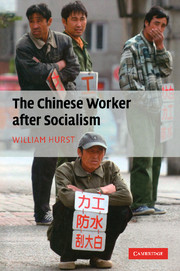Book contents
- Frontmatter
- Contents
- List of illustrations
- Preface
- Introduction
- 1 Regional political economy and labor reform
- 2 The roots of unemployment and the political economy of lay-offs
- 3 Remaking China's urban welfare and labor market policies
- 4 Pathways to re-employment
- 5 Contention, protest, and social order
- Conclusion
- Appendix: List of interviewees
- Bibliography
- Index
1 - Regional political economy and labor reform
Published online by Cambridge University Press: 02 July 2009
- Frontmatter
- Contents
- List of illustrations
- Preface
- Introduction
- 1 Regional political economy and labor reform
- 2 The roots of unemployment and the political economy of lay-offs
- 3 Remaking China's urban welfare and labor market policies
- 4 Pathways to re-employment
- 5 Contention, protest, and social order
- Conclusion
- Appendix: List of interviewees
- Bibliography
- Index
Summary
Introduction
My arguments to come are based on a subnational comparison of Chinese regions. This chapter outlines and defines the regions where lay-offs have occurred, reviews the historical roots of regional political economies, and specifies the dimensions of contemporary regional political economy that shaped relevant outcomes of SOE labor reform.
While regional analysis is not unknown in the study of China, the particular type of subnational comparison employed here has not been widely used by China scholars. Specifically, I first seek to divide China into meaningful subnational units. This is a step that previous scholarship has often paid insufficient attention to. The next step is to define important variables on which these units differ. Finally, representative localities from within the units must be selected for more intensive study. Each step is discussed below.
Lay-offs and regions in China
No one disputes the vast scale of job losses. Approximately 143,131,500 workers were employed in SOEs and urban collectives at the end of 1993. By the end of 2002, only 79,947,000 were still on the job. This represents a net loss of more than 63 million jobs – roughly a 44 percent reduction of the 1993 state sector workforce within a 10-year period. A further 7 million jobs were lost, by official count, between 2002 and 2004, and nearly 3 million more by the end of 2005.
But lay-offs were not an equally significant issue in all parts of China. This should be no surprise.
- Type
- Chapter
- Information
- The Chinese Worker after Socialism , pp. 16 - 36Publisher: Cambridge University PressPrint publication year: 2009

